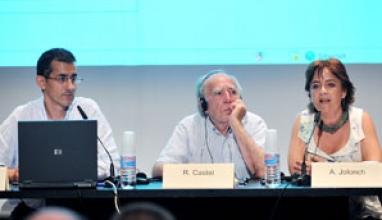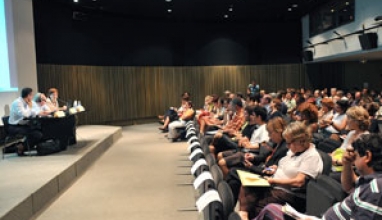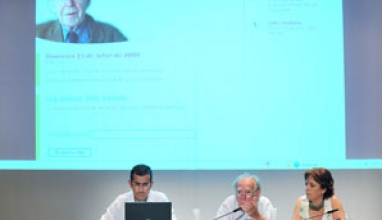You are here
The Crisis of Social Cohesion: School and Employment at a Time of Uncertainty
About the speaker
Robert Castel
Sociologist and Head of Studies at Paris's École des Hautes Études en Sciences Sociales (EHESS)
What has caused the present crisis?
The crisis that we are currently facing is a dramatic episode of a deeper process of crisis that saw its origins at the end of the 1970s and which has three principal axes:
• The change from an industrial capitalism to a fierce and savage multinational capitalism hugely controlled by the financial world.
• The social protection system entering a crisis, which also affects social structures such as education.
• Rise in the importance of the individual over the group.
Background
• In the 1960s, industrial capitalism had reached a balance between the interests of the capital and the proletariat, which was resigned to some salary submission but which benefited from some degree of employment protection: minimum wage, right to health, unemployment, retirement, compensation.
• Employment conditions guaranteed the economic and social independence of the individual. Workers became individuals with full legal rights in society.
• Collective interest prevailed and demands were also collective. It was the age of collective agreements, mass trades unions, of many workers in the same employment conditions.
• Individuals had a right to efficient public services. The state ensured that certain services regarded as priority (such as education) were not in private hands. The state was the group of groups that guaranteed services and afforded them legal value.
The end of industrial capitalism in the 1970s
A dynamic of decollectivisation and reindividualisation began.
A. Changes in employment relations
• Individualisation of work. The individual worker (not the group) was asked for mobility, adaptability and flexibility.
• More precarious and less regulated professional careers. Temporary contracts and subcontracted staff increased. Things went from almost full employment to mass unemployment. Workers had to live with continuous work changes and periods of work and unemployment.
B. Changes in the system of social guarantees
• It has been repeated for 30 years that employment rights are an obstacle to the free development of businesses and laws tend to deregulate social protection.
• The new system does not guarantee work for everyone and therefore neither can the social protection systems (financed by salaries and businesses) be guaranteed.
• Precarious forms of work (temporary contracts, hidden economy) do not give rights at the same level of social protection as stable employment.
• Workers in precarious jobs end up being half-marginalised half-workers because the resources they get from work and social protection are not enough for them to develop as individuals with full legal rights.
French example: A process of commercialisation of social aid is being experienced. It is the example of the assisted contract and of active solidarity income. They foster people re-entering work for a few hours a week or a for a few months a year in order to get social aids. A balancing entry is required to get economic compensation. ?It is too high a requirement for people who cannot take it on.?
C. Change in the individual
• Growing degradation of the individual due to increasing employment and social precariousness. The modern individual relies on property. If the individual does not have enough resources, it becomes like in the age of the industrial revolution again: the proletarian was not considered as an individual but as a barbarian. The proletarian without resources could not be free and responsible.
• The long-term unemployed or young people who cannot find work are more fragile individuals who do not have the means for self-realisation.
• A confrontation arises: on the one hand, individualism is exalted (individual initiative, freeing oneself from state limits), and on the other, the opportunities for everyone to live as a free individual do not occur.
Conclusion
The detonator of the current crisis was the financial system, but in reality there is an underlying systemic crisis. This crisis would not have come about had there not also been a crisis in the organisation of employment and in social protection.
How the systemic crisis affects education
• The crisis affects all social spheres, such as school or family. We can speak of a crisis in the educational system as another facet of the general crisis. The school crisis occurs due to the situations of precariousness and marginalisation of certain categories of the population.
• In the case of France, before the crisis, school played a homogenising role (in terms of knowledge and development opportunities) and was a relevant element of socialisation.
• The modern school has difficulties in being homogenising. This is borne out by the high rate of school failure or drop-out among certain social groups. The ideal of offering everyone the same opportunities to achieve success doe s not work in precarious social situations.
• In France, there is a commitment to positive discrimination so that the groups with the greatest difficulties for success achieve better results. However, it is a controversial initiative and one that is opposed by everyone who continues to defend that school should be homogeneous.
Discover
other ideas
-

Leadership in innovative educational organisations
David Hopkins
2009 -

Schools and immigration: ideas and realities
Julio Carabaña
2009 -

Responsibility, autonomy and evaluations for the i...
Mats Ekholm
2009



















 The texts published on this website are, unless otherwise indicated, covered by the Creative Commons Spain Attribution - Non Commercial - No Derivs 3.0 licence. You may copy, distribute and transmit the work, provided you attribute it (authorship, journal name, publisher) in the manner specified by the author(s) or licensor(s). You may not use the material for commercial purposes. You may not transmit any derivative work from this material. The full text of the licence can be consulted here:
The texts published on this website are, unless otherwise indicated, covered by the Creative Commons Spain Attribution - Non Commercial - No Derivs 3.0 licence. You may copy, distribute and transmit the work, provided you attribute it (authorship, journal name, publisher) in the manner specified by the author(s) or licensor(s). You may not use the material for commercial purposes. You may not transmit any derivative work from this material. The full text of the licence can be consulted here: